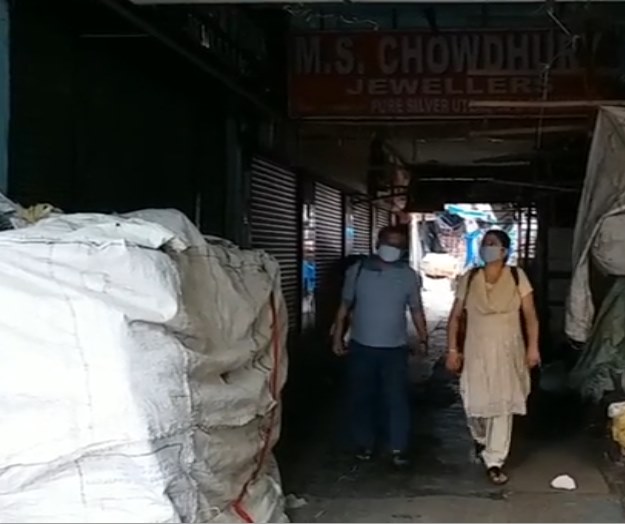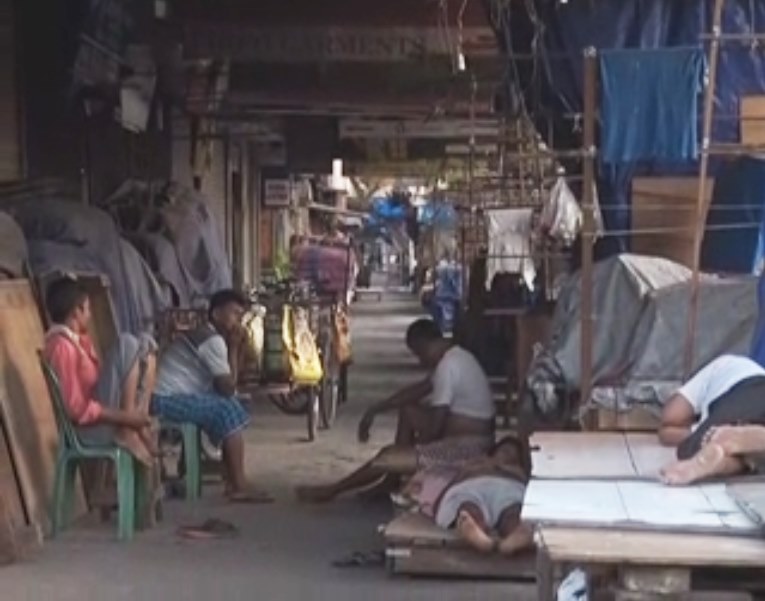kolkata: A middle-aged man and a woman gradually stroll along the pavements of Gariahat in Kolkata. Both have masks firmly placed on their faces and as they walk along the pavements, a practiced maneuver keeps on fooling them every now and then.
The manoeuvre is one of dodging numerous street vendors hawking anything and everything on the pavements, which are mostly chock-a-block with shoppers. The man suddenly lowers his head and tries to duck invisible salwar-kameez sets usually dangling from protruded poles on the pavement to woo buyers, but soon realises that he doesn't need to duck any more, or any time soon. There is nothing hanging from anything.
The Covid-19 lockdown and social distancing norms have dealt a body blow to the bustling hawkers enclave of Gariahat in south Kolkata, Hatibagan in the northern part of the metropolis and also the New Market area in the central business district of Esplanade.

Cities across India are limping back to normal, but be it in Mumbai or Kolkata or for that reason Delhi or Chennai – the most notable presence of hawkers or street vendors are completely missing.
Kolkata's civic department has given nod to partial opening of the bustling hawkers' market on May 27, but most vendors have simply not turned up. Wares tightly wrapped up in plastic sheets only bear the silent testimony to the once hustle and bustle all around.
Asim Halder of Kolkata sells night dresses on the pavements of Gariahat. He is among the few who has tried to start afresh.

“Last year during this time as well as during Poila Boishakh (Bengali New Year's Day) in April, I had to hire two extra hands to tackle the swarm of customers. For this year, like many of us, I also stocked up. But, this lockdown has finished me. No customers, no sale, just nothing. I have used up all my savings in the last two months. My daughter studies and I can't stop everything. These days, in the afternoon I don't know what my wife will cook for dinner. It literally come to hand to mouth situation. I also don't know when will all this end and when will customers show up... I just don't know anything. This shop is all I have got. I have opened it again. Let's see what is in store for us,” Halder said while staring at the vacant pavement ahead.
The pandemic has impacted livelihoods of many street vendors like Asim across the country. This primarily unorganised sector dealing in vegetables, fruits, ready-to-eat street food, tea, snacks, breads, eggs, textile, apparel, artisan products, books and stationary, are simply at a loss. Even services like barber shops, cobblers, betel (pan) shops to even laundry outlets, the chain has simply broken off.

The Centre at the center
The Centre has extended Rs 5,000 crore special credit aimed at benefiting 500 lakh street vendors across the country under the Atma Nirbhar Bharat project. The modalities of extending such a benefit are yet to be decided and the Union Finance Minister had asked for a month's time to formulate the modalities. But, lakhs across the country like Asim in Kolkata, have run out of time, only adding to the steadily rising numbers of the urban poor.

Urgent Need of Cash
“Hawkers need cash in hand, they do not need credit,” Saktiman Ghosh , General Secretary of the National Federation of Hawkers, told ETV Bharat. The National Hawkers Federation is an association of street vendors across 28 states in India, with 1,188 unions including 11 Central Trade Unions and 20 International Trade Unions abroad.
“Hawkers are an intricate part of the country's economy and are crucial for the sustenance of a large strata – right from the urban poor to the middle class. They are at the helm of a low circuit economy with a daily turnover of Rs 8,600 crore across the country. These hawkers are also an important part of the supply and demand value chain. The Centre's initiative for hawkers is a good move, but with two months of simply no business, the street vendors of India have gone bankrupt. Unless they get some cash in their hands as working capital, they won't be in a position to make the most of this credit scheme. So, we requested the Government to extend cash benefits of Rs 6,000 for at least six months to the hawkers. This will ensure the much required liquidity in the market,” Ghosh said.

The progress so far
On the modalities front, Ghosh says the Centre had proposed funding through private banks, but the Federation wanted disbursing funds should happen only under the Mudra scheme with a subsidy. The proposal has been accepted and a draft scheme is now with the Federation for recommendations.
Bankers' concerns
The Centre's boost for the hawkers is supposed to allow a minimum credit of Rs 10,000. It also aims at facilitating incentivised digital payment through monetary rewards and availability of working capital credit for good repayment behaviour. But, confusion prevails on the whole matter.

Bankers' associations have raised concerns about the modalities of the credit scheme. Concerns have been raised that credit under the scheme could turn into NPAs (non-performing assets) as most of the banks do not have the experience of dealing with such low level credit lending.
Lack of information about the credit history of the beneficiaries is another challenge which is staring at the bankers. They feel, usually in such low circuit economies, the micro lending concept works as lenders remain in regular touch with the beneficiaries.

But, not all share the same concerns.
Sanjay Das, Secretary of Bankers' Federation India, West Bengal chapter, told ETV Bharat that, “There is urgent need of cash flow in the market. Only then will the supply demand chain, a quintessential factor for any economy, be maintained.”
Cheap Distribution Network
“Hawkers not only cater to the urban households, they also form a cheap distribution network for farmers as well as small and micro-enterprises in the informal sector. Manufacturers and producers operate on a shoestring budget and cannot always afford retail outlets. For them, these street vendors are the only means to reach the customers,” Das says.
“During these critical times, unnecessary assumptions will lead to complications. The possibility of failures in loan repayment is always there, but when the country has cases of multi-crore scams and frauds, non-payment of a Rs 10,000 here and there, is just nothing. Compare that with the intended jump start that the street vendors will get. At least some of their lives will be saved,” Das adds.

The street vendors of India
The high pitched hawking and last minute bargaining in Janpath or Sarojini Nagar Market in Delhi, Colaba Causeway, Linking Road, Hill Road or Hindmata Market in Mumbai, T Nagar in Chennai or for that reason, in the hawkers' markets of Kolkata, are simply missing.
Out of four metro cities, only Gariahat Market in Kolkata has re-opened and that too partially. To maintain the social distancing norms, hawkers will have to operate on a rotational basis.
There is still no information as to when the other markets will be re-open. “In most places street vendors selling fruits, vegetables and groceries will only be allowed to operate, initially. We don't know what will happen to the others,” Ghosh said.

The Pressure on Pavements
Saktiman Ghosh says recent job cuts in cab aggregators as well non-plying of private passenger transport, have rendered a large number of people jobless, eventually leading to shifting of job roles. Many have started selling fruits, vegetables and grocery for livelihood, leading to a sudden surge in the number of vendors.
“The Covid-19 lockdown has rendered both sellers and the buyers of this low economy circuit helpless. Then there are social distancing norms, sanitisation costs, difficulty in availability of cheap mode of transport and above all, lack of customers. We are staring at total disruption in the fabric of the society across India,” Ghosh added.
Only time will tell if the blank stare of Halder on a deserted pavement in Kolkata, gets some glint. And if at all it happens, when? Till then, the elusive ducking seems to be the new normal for the pavements of India's metropolises.
(ETV Bharat Report)



